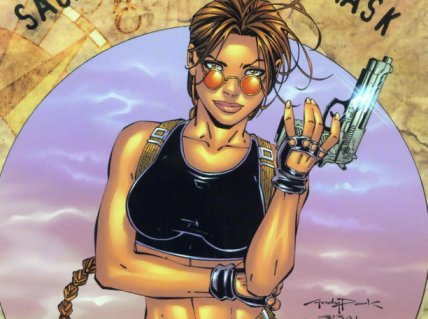
Once the era of PS1 domination hit in the late 90's, it was only a matter of time until the comic book biz got their claws into gaming's newest star, top-heavy countess Lara Croft.

Ever since Raiders of the Lost Ark came out there's been a never-ending deluge of action heroes who are also archaeologists. The concept has only really caught on as a true cultural phenomenon twice, however--first with the original, Indiana Jones, and then in 1996 when Lara creator Toby Gard inverted the formula. Instead of a macho tough American in a fedora, Gard cast a sophisticated well-bred female Briton in the role, deliberately doing the opposite of what the marketing department was hoping for. The gamble paid off, Lara became an icon, and Core Design made the same game about twenty times before everyone got sick to death of it and their privileges were taken away. To have a game with the Tomb Raider label in your house once meant you were ignorant, but skies are sunnier now that a different developer makes her most recent titles.
Lara is a globetrotting studier of ancient cultures who is "extraordinary wealthy," as one typo put it. Her parents were originally alive, but that status was later retconned into "dead," so Lara could be even more extraordinary wealthy. Lara can read ancient languages no one else on Earth can read and she can solve puzzles that have stumped other archaeologists for hundreds of years and she knows the last digit of Pi and she knows who Carly Simon was singing to in "You're So Vain." Lara lives in a big fat palace with Pandora's Box in her attic and King Arthur's sword in her den and the Philosopher's Stone in her koi pond and Hitler's brain in her refrigerator next to the mayonnaise. Lara has fought dinosaurs and dictators and stormtroopers and T-1000s and Queen Aliens and she never loses and she can somersault faster than bullets and she's been to Atlantis and El Dorado and Shangri-La and she's tasted a rainbow, and by that I don't mean the Skittles slogan, I mean she's actually gotten close enough to a rainbow to lick it, and she's found Elvis and she found D.B. Cooper's stolen money before the Prison Break guys ever did, and she's punched out Muhammad Ali and the Russian Robotic Boxer from Rocky IV and several demi-gods, and she's found the world's last living dodo and eaten it. Lara is, like Batman, a character that teeters dangerously on the edge of camp, and in order to write an effective Tomb Raider story, you shouldn't let her fall off that edge. This is what happens if you don't:
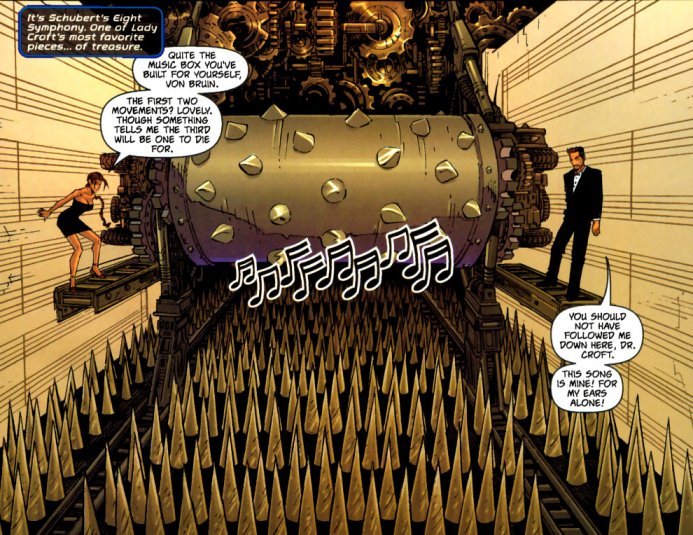
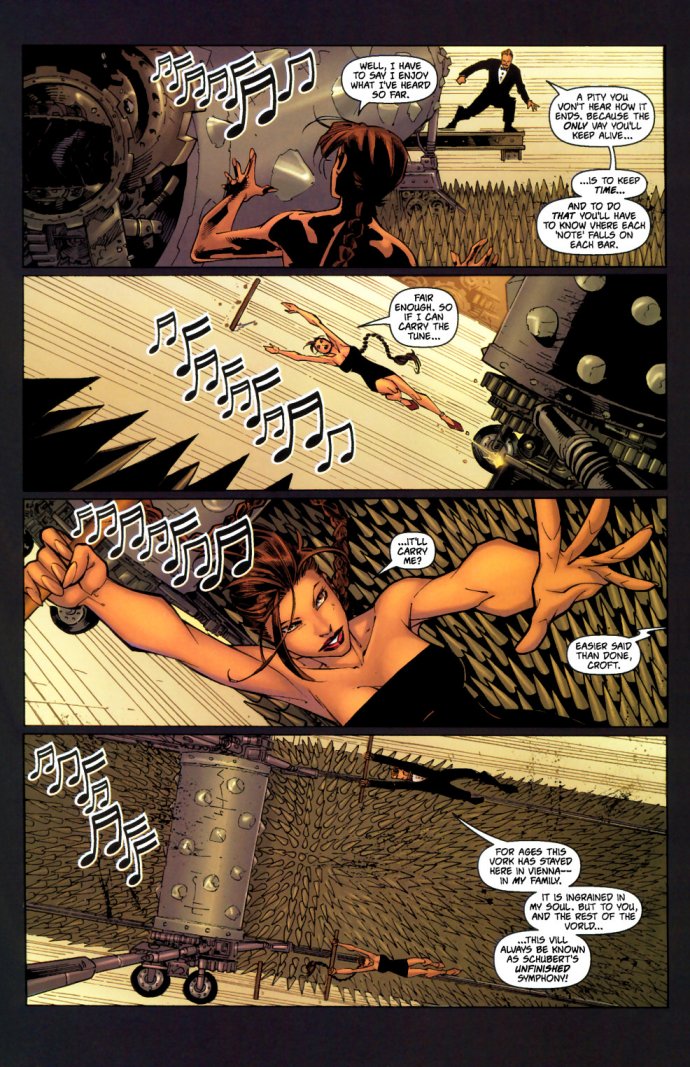
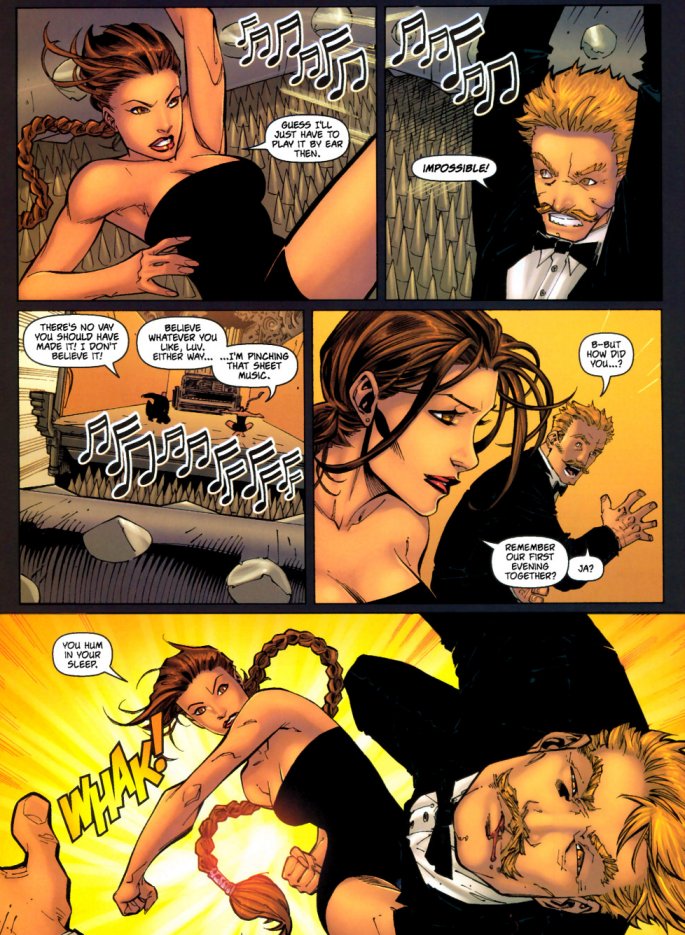
Sux, don't it?
If I were writing for Lara Croft I'd look to The Oddyssey for inspiration. That story has survived for so long because it's fascinating how King Oddysseus beat all those incredible odds to get back home. Likewise, Lara often finds herself up against super-powerful masters of the universe with only a pair of pistols to defend herself. Yet she always finds a way to get out of whatever she gets herself into. But how? How does she do it? See, that's an interesting framework to work with.
But all too often Lara goes up against things way more powerful than her and shoots one bullet and it hits the monster point-blank in the head and it dies. That's her problem. Several of the writers just made her too darn invincible. Also, scenarios like getting stuck in a giant music box with spikes on the bottom are stupid.
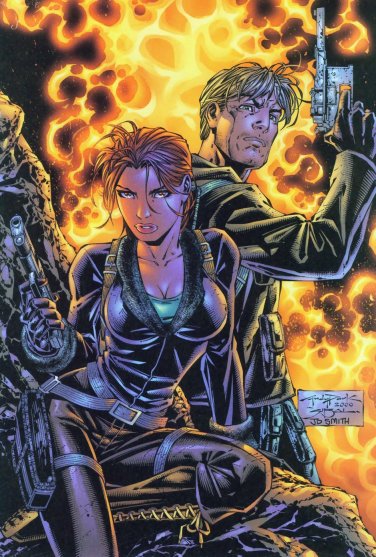 |
Tomb Raider #1 introduced a comic-only
character, Chase Carver. Chase is another treasure
hunter, but not the best in the world. He and Lara were
once an item until she caught him with another woman (and
found out he'd robbed her, to boot). Chase re-emerged in
the first adventure interested in winning Lara back, but
she'd have none of it, which led to many entertaining
back-and-forth bickerments as they found themselves
uncomfortably working together. Chase essentially became Lara's Ron Stoppable in future issues, often serving as the comic relief or the muck-up to one of Lara's perfect plans. The dynamic worked rather well for the time it lasted. |
Tomb Raider, the comic book, began with the four-part "Saga of the Medusa Mask" that introduced Lara, Chase, and a very out-of-place butler. As Lara searches for the Medusa Mask, she runs into several bullet-ridden attempts to stop her. She's led to believe the guy behind these is Chase, but it turns out to be the butler, who's secretly been evil for Lara's entire life but was just waiting for the opportunity to pounce and kill her!! ....Then if you go back and read Part One, several of the things the butler says now make no sense. When he does things like shield Lara's body from shooters....why, now, if he wants her dead? It pretty much reads like they made up that twist later.
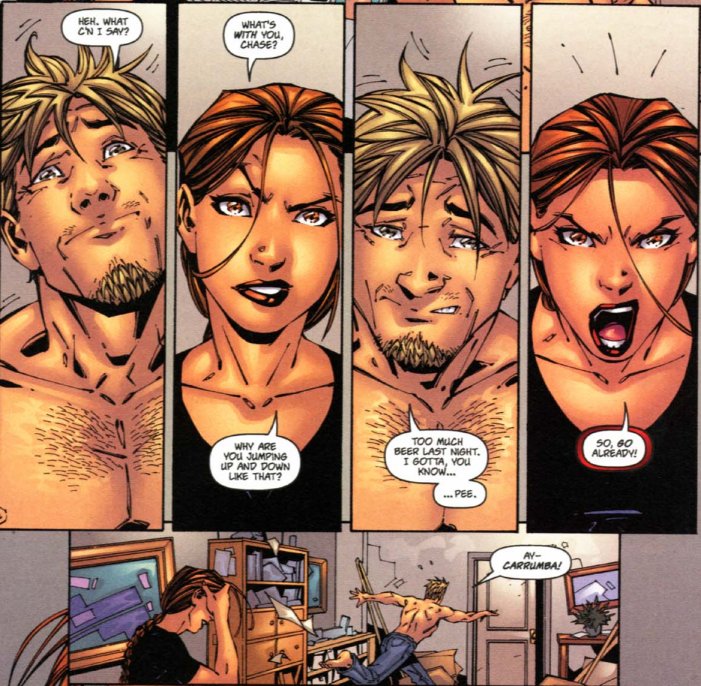
The early Tomb Raider issues followed the proper tomb-raiding formula and earned a sizable audience. It was later on, after the comic was a success, that it started falling prey to the Laws of Comic Book Doom.
LAW OF DOOM #1: A new writer comes aboard, looks at a beloved character and is the one person who can't stand that character, so he kills said character off.
Said character was Chase, who fell victim to a booby trap around issue number 15.
LAW OF DOOM #2: Story decisions are made from a business viewpoint instead of from a creative one.
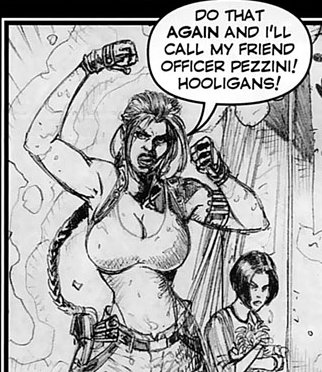
Translation: Top Cow started using the Tomb Raider book to promote other books. Lara suddenly became friends with the heroine of Witchblade, their most popular title (which, thusly, didn't really need the promotion). Instead of temples and booby traps, Lara began battling the kinds of enemies Sara Pezzini faced...generic monsters. It didn't feel so Tomb Raider-y anymore.
LAW OF DOOM #3: Having your main character actually "die." (This one's the worst, people. Don't EVER do this.)
The quality plunged down a well once the result of this team-up ended up killing Lara.
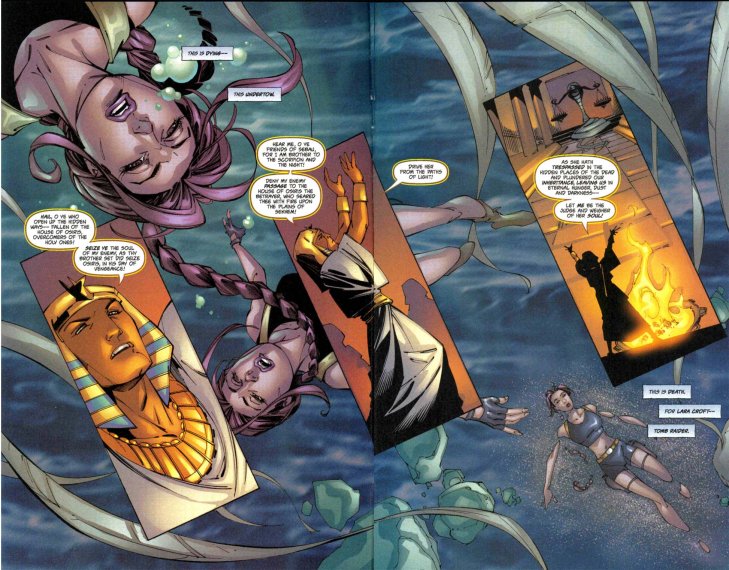
You take away the most fundamental element of an adventure series--the fear of death's permanence--and you destroy the series itself. (This is a big reason why most comics are in such a mess.) Of course she had to come back, yet she went to the Egyptian afterlife for some reason, and spent the next three issues in an extremely confusing and narratively overwrought netherworld. Nothing she did there affected her return to the flesh; someone just decided her life wasn't over yet at the end and sent her back.
But---oh noooo! She returned to find that, since England thought she was dead, it gave her entire estate to someone else! And that someone else is a BIG UGLY MONSTER!! Without large financial backing, she can't be the Tomb Raider anymore! Was this the end?? (In normal circumstances, I think her showing up alive would have negated this decision, but....not this time.)
Ah, but it's worse! The monster will return her estate and give her life back--only if she retrieves a powerful ancient thingy for him! "No way," says Lara, "I couldn't live with myself if I helped a big monster like you!"
"That's what you think--I
have even more leverage! If you don't do it...I'LL KILL
THIS BLAND LOVE INTEREST OF YOURS THAT WAS ONLY INTRODUCED IN ONE
PREVIOUS ISSUE AND NOBODY READING THIS COMIC CARES ABOUT!!!"
"NOOOOOO!! Now I have no choice but to help you!"
anguishes Lara.
So she spends the next few issues tracking down the stupid thing the monster wants, then battling the monster, then killing the monster. Then the boring guy dies anyway, but only Lara cares, and after ten full issues that is the grateful end to the entire messy saga.
Then the comic had to start tieing in the latest and most infamous Tomb Raider game, Angel of Darkness. One problem with this, among others, was that the plot involved the murder of one of Lara's mentors....who had never been in the comic before. So in this version she just mentioned that she always knew him, and he appeared for two pages before being shot. This was 2003, the release of Cradle of Life, the release of Lara's worst game and the release of her worst comic issues. The darkest year in her history by far.
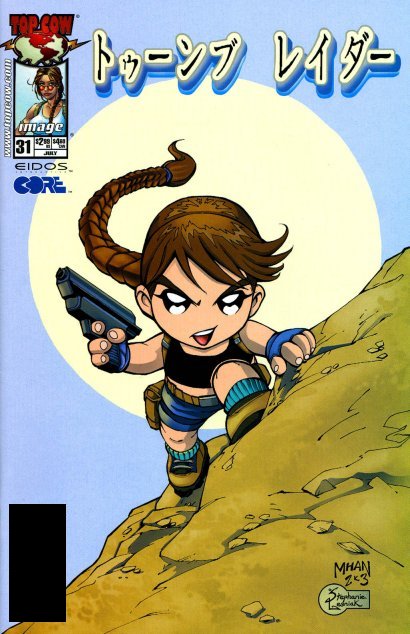
While the quality never again approached the pre-tie-in years, it gradually offered a few more satisfactory moments. The writing became less convoluted and the super-multi-part storylines were changed to simpler two-issue arcs. They started getting more creative with the globetrotting settings: one issue was like a Western; another two-parter had Lara inside a haunted castle. One brain-dead story had Lara teaming up with a Native American named--no kidding, his name was this bad--"Joe Notafraid." With sidekicks like this, people were still writing into the comic's mail column begging for Chase to return. These requests were ignored.
Within Lara's last ten issues, a new villain was introduced--a rich Australian fatso named Mr. Aulgood. I couldn't tell if this guy was supposed to be taken seriously or not. I mean, look at him....
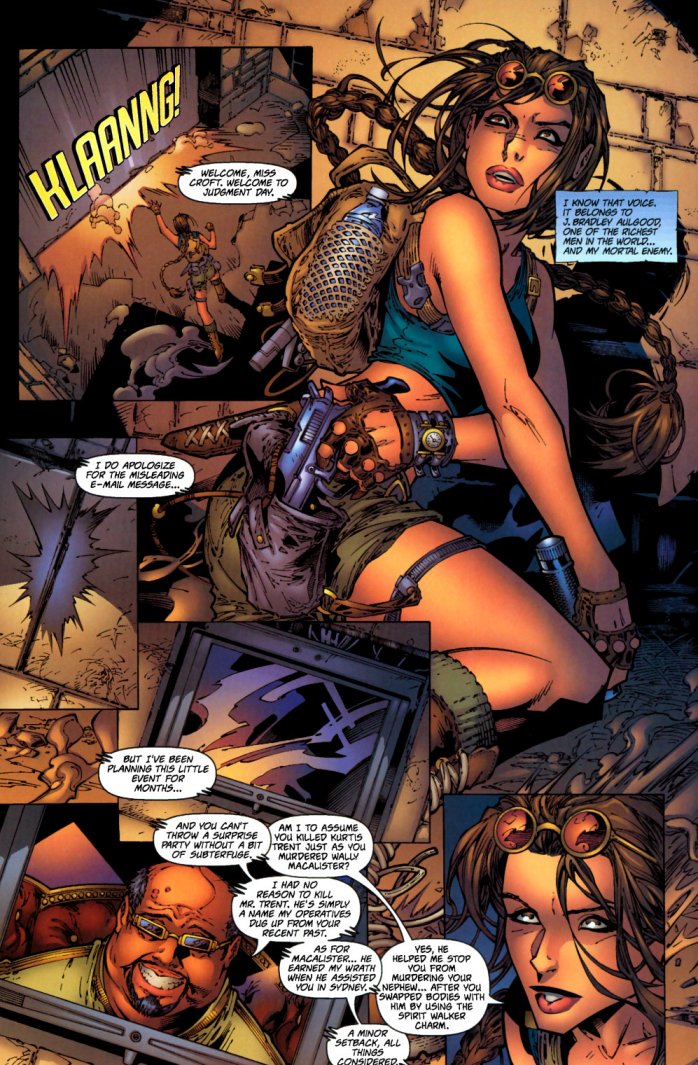
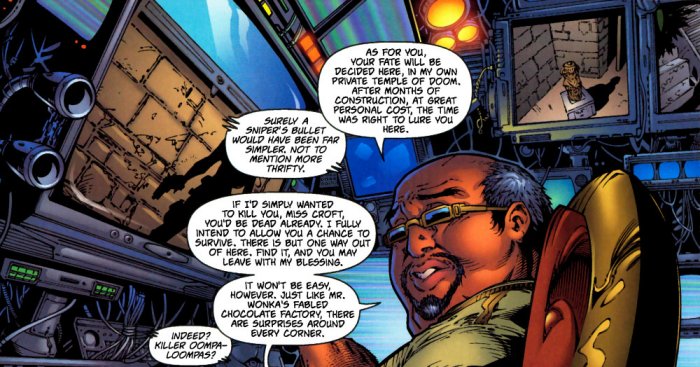
Lara, however, took him very seriously: "This is the most powerful villain I've ever faced! He's so rich, there's no place in the world I can't hide from him! This will be the most climactic battle I've ever fought in my entire life!!"
Was it? Umm....no. The Most Climactic Battle She'd Ever Fought In Her Entire Life was cut to one issue to allow space for yet another tie-in promoting a new Top Cow book. The quick version was what you see up there: a big, large, expensive, stupid trap that Fatso definitely overpaid for. The end result was that he was devoured by a tiger. OR WAS HE?.....nah, he was, I don't want him back.
Top Cow put the series on hiatus at issue 50, and has yet to continue publishing it. If you want more comics, you'll have to turn to this site. And you'll have to bring money.
For all the different directions the Tomb Raider comic tried to take, the end analysis is that the original formula worked best. Lara is most entertaining when she's doing what she's supposed to be doing--venturing into abandoned and dangerous temples, escaping booby traps, encountering bizarre ancient supernaturalisms, and rescuing fabulous treasure. It's just that simple.